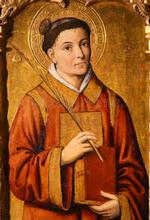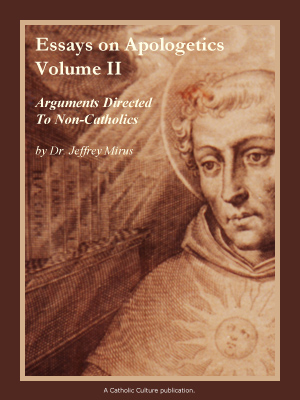Revival Afoot: Traditional Sacred Architecture
Liturgical design consultants, despair now! A new breed of archi-liturgical enthusiasts are making waves on the church architecture scene. Led in the U.S. by Notre Dame professors Duncan Stroik and Thomas Gordon Smith, they seem to be tweaking their elder modernist brothers and sisters who have dominated the profession since the mid-1960's (and have grown old doing so). As evidenced by a recent rant in the National Catholic Reporter (NCR), the liturgical modernists who have had a death grip on both the liturgy and the design of Catholic churches seem to be distressed at the growing movement of young architects who are embracing the rich history and patrimony of church architecture and building traditions. Porticos, bell towers, colonnades, vaulting, stained glass, baldachinos, prominent tabernacles, wooden pews, kneelers, statues, murals, crucifixes, and devotional shrines are some of the common traditional elements used in the design of their new churches.
Writing in the NCR, Michael DeSanctis, associate professor of fine arts at Erie's Gannon University and traveling LDC, takes Stroik and Smith to task for their desire to rid Catholicism of the barren, uninspiring worship spaces of recent decades. Calling them and their cohort "blatant opportunists," "the stodgiest of antiquarians" "recyclers of architectural fashion," "paranoid and self-righteous Pharisees," DeSanctis condemns the neo-Classicists' desire to build upon the rock of history and eschew the modernism that has defaced our Catholic architecture for more than three decades.
Indignant over the fact that the young architects are gaining a following among the laity, DeSanctis sums up their quest as follows: "What [they] are proposing is not simply a 'preservationist' initiative concerned with maintaining existing churches in the classical style. Instead, they envision a generation of entirely new places of Catholic worship built along classical lines that will set the church again on a proper liturgical-architectural path." As the LDC crowd despairs over this, the pew Catholic rejoices.
DeSanctis laments too their growing influence among the clergy—especially the younger clergy—who have grown tired of the endless failed experiments demanded by American liturgists and LDCs. "By proposing to replace [the modern churches] with an expanse of antiquated shrine boxes, Stroik and Smith are bound to ingratiate themselves to today's tabernacle-obsessed bishops, biretta-topped seminarians and a handful of cardboard monsignori," he writes.
But the likes of Stroik and Smith are simply asking the pertinent question: How can we recover our sense of the sacred in Catholic church buildings? Fortunately more architects are asking themselves this question. Yet few can honestly set the marvels of classical art against the drabness of modernist production, and argue in favor of modernism as does DeSanctis. Contrary to this LDC's claim, there is more than simply anecdotal evidence that pew Catholics are saddened by—and sometimes disgusted with—their modernist churches of the late 20th century. Bishop Sean O' Malley of Fall River, Mass., speaking to the American bishops at their national conference last November, stated it well: "All of us have heard the comments of our people frequently, 'this place does not look like a church.' One of the comments that is made is that there's a certain suburbanization of the heavenly Jerusalem that has taken place." Although the sentiments of the faithful are well-known, liturgical design consultants, mainly "certified" by reductionist and modernist-oriented programs at the Catholic Theological Union in Chicago, have long refused to hear the complaints of the faithful. Instead, their cries are dismissed as coming from people who are "resistant to change," even though many of them (such as this writer) are in their 20's or 30's.
A breath of fresh air
Now, after more than half a century of riding the modernist bandwagon, professional artists and architects are emerging with the critiques of our secularized churches. And unlike the layman, they are able to articulate the problem and define appropriate solutions. In recent years some have been actively probing tradition in order to develop the domus Dei of the 21st century. One hopeful sign of the revival of traditional architecture was an exhibition and conference held last October in Rome. "Reconquering Sacred Space" brought together more than forty artists and architects from the U.S. and Europe to showcase their traditional church designs, in hopes of promoting sacred architecture that can properly carry the weight of religious symbolism and provide a suitable and noble place in which to worship God. The work is now presented in a 150-page color folio of the exhibition. Published in English and Italian, Reconquering Sacred Space presents inspiring drawings and plans of theoretical projects as well as completed buildings.
Stroik and Smith are joined by American architects such as Steven Schloeder (author of Architecture in Communion) and Michael Imber, as well as notable European counterparts, including Javier Cotelo, Anthony Delarue, and Santiago Hernandez. The frescoes, murals, and sculptures of artists David Mayernik, Hamilton Reed Armstrong, and Frederick Hart give us hope that sacred art is undergoing a renaissance as well.
Ten essays on the tradition of Classical architecture, the importance of symbolism and iconography, the limitations of abstract modernism, and new directions in sacred architecture complement the visual projects. In Stroik' s contribution, the Indiana architect articulates the ideal genius loci of the Catholic church building: "People should see and feel that they are entering into a place out of the ordinary, a place in which the concerns of life can be seen in relation to eternity." A certain sense of mystery or strangeness ought to characterize our places of worship, he suggests. "A sacred place should not be convenient to enter like a department store, comfortable like a café, or predictable like a lecture hall," writes Stroik. "Rather as a place whose reason for existence is to foster the encounter with the divine, it must be designed in a way helping us to focus on the Divinity."
Although some of the more fashionable gewgaws of the day (immersion-style fonts, for example) have made their way into some of the featured projects, the majority are fully conceived and executed against the grain of modernism, and all projects are recognizable as church buildings, a point that should not be undervalued. One of the central themes running through the selected projects, in fact, is the emphasis on the "iconic" nature of building form. In layman's terms that means the form of the church building has meaning beyond itself; it refers to God, His Sacraments, His Church. We see bas-reliefs of the Eucharist, personification of the virtues, urban piazzas, and triumphal arches, all imbued with layers of religious meaning and significance—churches that are worth a pilgrim's attention, and are able to care for a parish community for more than a generation. The same careful treatment is given the interior sacred places. Architectural elements articulate the sanctuary, altar, tabernacle, confessional, altar rail and shrines within. The architects consciously give honor to the sacraments through the placement and treatment of these physical manifestations of our faith. Furthermore, coherence and unity are apparent in these buildings which are designed using the patrimony of Classical or Medieval architectural languages.
Another noteworthy element of the exhibition and essays is the relation of the church building to the city. In Gabriele Tagliaventi's essay on the role of the church in building western cities, he reminds us of the physical role of the Gothic church standing above the medieval cityscape, organizing the village. Speaking of the great Cathedral of St. Etienne in Metz, Germany, he notes that "all the main activities are gathered around the Cathedral: City Hall, the marketplace, leaving the religious building the task of symbolizing the spiritual unity of the community." He and others are promoting the revival of piazzas, the age-old element of mediation between the Church and the city, and other elements of Renaissance urbanism. God willing, more people will come to understand the church building as more than just its four walls, but as the heart of the city or neighborhood, the lungs of the community.
In short, the book gives those of us who are unable to attend such wonderful gatherings in Rome each year an opportunity to understand the possibilities of new Catholic church architecture based on the traditional language of the Church. What a wonderful counter to the banal and uninspiring designs promoted throughout the Catholic world at the turn of the century. The final word is hope, and the casual reader can appreciate this important virtue on every page of the book. END
The exhibition was jointly organized by Stroik's Institute of Sacred Architecture and the Agenzia per la Citta of Rome. Reconquering Sacred Spaces is available from New Hope Publications for $34.95 (including postage and handling), 3050 Gap Knob Rd., New Hope, Ky. 40052.
Copyright 1999 Aquinas Publishing Ltd. All Rights Reserved
This item 2877 digitally provided courtesy of CatholicCulture.org






